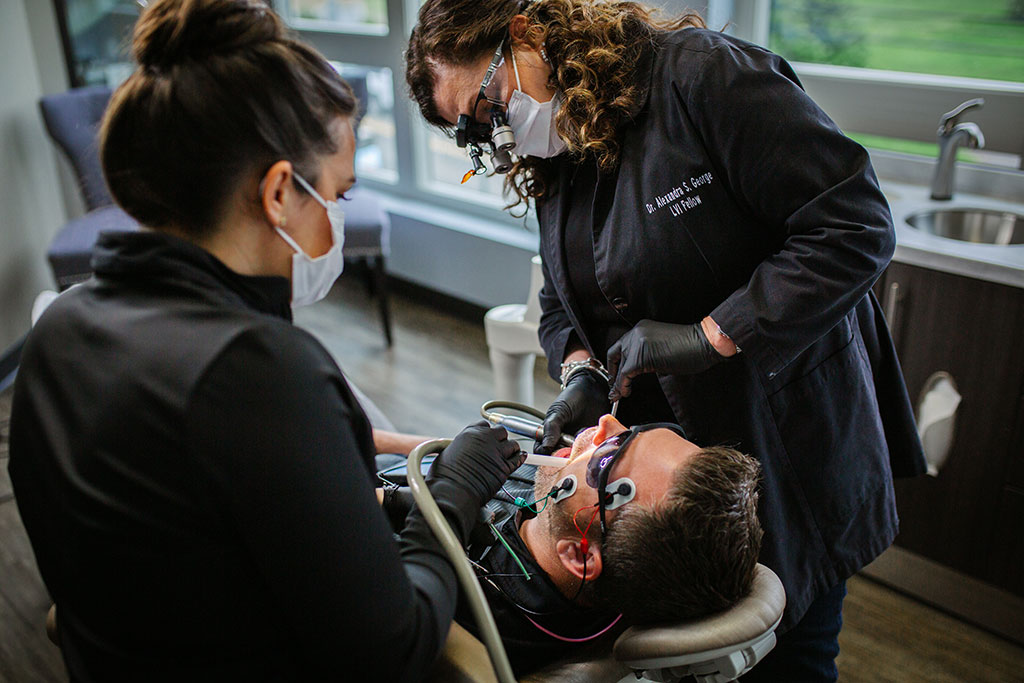Is DTR Therapy right for you?
If you’re experiencing any of the following, you may benefit from DTR Therapy:
- TMJ/D symptoms and/or diagnosis
- Bite feels off/pain after dental work
- Bite feels off/pain after braces or Invisalign
- Unanswered questions and misdiagnosed pain
Your treatment plan
DTR Therapy involves the latest technology to identify where friction and stress are causing muscles to hyperfunction into a painful state. With this information, we can effectively adjust teeth into a balanced bite without the use of appliances, medication, injections, or surgery. DTR Therapy is a minimally-invasive solution that can help relieve you of pain and discomfort in 1-3 appointments.
How DTR Therapy works
DTR therapy uses Tekscan and EMG technology to provide us with accurate measurements of a patient’s bite and identify contacts that may be leading to hyperactive muscles, breakage, and TMJD symptoms. DTR Therapy works by:
- Measuring pressure, timing, and muscle activity.
- Making accurate micro-adjustments with the data gathered.
- Achieving a better-balanced bite and more functional bite activity.
When the timing and force of your bite are not aligned, the jaw muscles become overworked and lead to jaw pain, headaches, and neck tension. DTR Therapy allows us to have a more comprehensive view of the joint and accurately identify where the uneven pressure is located. Patients can expect to see results after just one appointment, often reporting a reduction in discomfort, pain, and popping/clicking of the jaw.
DTR Therapy to treat TMJ disorder
DTR Therapy can be a successful temporomandibular joint disorder treatment. One of the most prominent symptoms of TMJD is chronic occluso-muscle pain that can significantly impact a person’s quality of life. Muscular symptoms of TMJD are prompted by hyperactive muscles in the jaw from prolonged disclusion time, surface friction, and occlusal obstructions during normal day-to-day movements, such as eating and talking.
In this case study featured in the National Library of Medicine, a patient with prolonged disclusion time is treated with DTR Therapy. T-Scan technology accurately measured occlusal contact time and bite force of four muscles that are activated when chewing and biting. Using this data, enameloplasty (the removal of tooth enamel in small amounts) was performed, which successfully reduced the patient’s disclusion time and relieved discomfort.
Contact us for a consultation
DTR Therapy is not limited to treating TMJD. Some symptoms of TMJD, such as jaw pain and headaches, can be caused by other dental and health conditions. Dr. Alexandra S. George DDS operates with a ‘complete dentistry’ approach that involves a more in-depth look into the mechanical functions of the mouth, your overall health history, and any underlying conditions that can impact oral health.
With this approach, we can correctly diagnose the problem and create a treatment plan that is customized specifically for you. Your jaw is an important structure and one that we don’t often realize how much we use until consistent pain disrupts our ability to eat, speak, sleep, and function. If you’re currently living in consistent pain and discomfort, we can help you find relief. Contact us for your first consultation.


